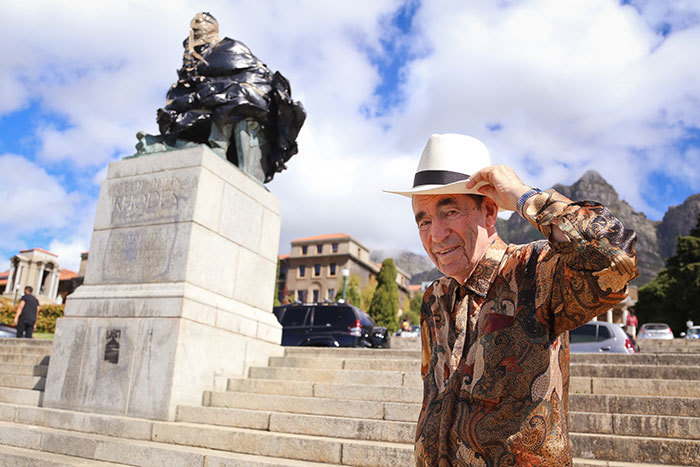The Rhodes debate: How we can have the last laugh
30 March 2015 | Story by Newsroom
Instead of extinguishing the man, we should keep him alive on campus and force him to witness our constitutional democracy, writes Albie Sachs.
While rushing up the steps at the University of Cape Town (UCT) to avoid being late for my early morning lectures, I always winced as I passed the statue of Cecil John Rhodes.
What a way to start the day – to be reminded of the persuasive power, not of reason, but of what had been the newly invented machine gun boastfully used by Rhodes to suppress resistance to conquest in Pondoland and Matabeleland.
But politically, we had more important fish to fry. Off the campus, I was waiting to hear if I, as a white person, could join the Defiance of Unjust Laws Campaign, until then restricted to black volunteers.
On the campus, we were fighting to destroy the rule that barred black students from participating in the university's social activities. My first public speech was to 1 000 highly vocal students in Jameson Hall.
My heart beat with terror and exhilaration as I felt myself issuing what I thought were thunderous denunciations of the ban against black students playing tennis or attending dances, only to be told afterwards: "That's just what we needed, Albie, a nice, quiet argument."
We weren't just acquiring knowledge and skills at UCT. We were learning about how to express ourselves, what it meant to be a human being and how best to struggle for a better society. Just like today.
At that time, I would have supported melting down the statue and selling the bronze to support scholarships for students from the Eastern Cape and Zimbabwe. Today, I feel there is a much more meaningful and creative way to go. Instead of extinguishing Rhodes, we should keep him alive on the campus and force him, even if posthumously, to witness surroundings that tell him and the world that he is now living in a constitutional democracy.
I can give two examples of how this was managed in similar situations. The first related to the question of what to do about historically offensive murals in South Africa House in Trafalgar Square, London. The first showed Jan van Riebeeck hoisting the Dutch East Indies flag; another depicted a bucolic wine farm – no slaves, no workers paid with bottles of wine.
The majority of South Africans were either rendered invisible or, at best, portrayed as smiling natives. Slavery, dispossession and disenfranchisement were simply not there.
As I recall, high commissioners Lindiwe Mabuza and Cheryl Carolus, both of whom had great cultural sensibility, confronted the issue.
My tentative proposal had been that instead of trying to blot out our history, we place batiks or other interesting works of art over the murals. In this way, the originals would not be destroyed and could even be exhibited from time to time to demonstrate the way white domination had been glorified in the past.
Happily, artist Willem Boshoff came up with a far more meaningful idea: to cover the murals with transparent glass panels that recorded the names of the indigenous people and slaves whose voices had been silenced in the past.
The result is striking. The viewer is compelled to look at and interpret the murals with present-day eyes and sensibility. A visually arresting and historically powerful new work of art emerged, based on seeking transformation rather than obliteration.
The second concerned the Old Fort Prison in Johannesburg, where the new Constitutional Court was to be built. Some people said the prison was a site of humiliation and despair that ought to be razed to make way for a hospital or school. We said no. There was too much history in those cells.
Britons, paid by Leander Jameson to seize the gold fields, had been locked up there; Boer rebels had later been hanged by the Brits on that site; Mahatma Gandhi, Oliver Tambo, Nelson Mandela and Joe Slovo had been detained there, as had men and women of the black consciousness generation.
Instead of trying to obliterate our history, we needed to honour those who had struggled for justice, and transform the area by setting up a dialogue between the past and present.
We organised an international competition for the new court building to be put up in the heart of the old prison. Alongside the international and local architects on the jury were Isaac Mogase, then mayor of Johannesburg, who had been locked up in Number Four, and Thenjiwe Mtintso, head of the Commission for Gender Equality, who had been held in the women's section.
A two-stage anonymous competition was won by young architects in Durban and a town planner in Johannesburg. Their design was based on placing a building representing justice under a tree right next to the walls of the notorious Number Four prison.
The result: a sharp and memorable dialogue was set up between the past and present. Constitution Hill has now become one of the most widely acknowledged and admired sites of conscience in the country and, indeed, the world.
My proposal, then, is that UCT lay down the principles based on the antiracist values of our Constitution, which should guide the transformation of the Rhodes statue; invite the public and professionals to produce designs for the creation of an imaginative and renovated space in which the statue should be located; and, finally, establish a broadly based panel, in which the current generation of students would have a strong voice, to choose the most appropriate entry.
In this way, we could have the last laugh on Rhodes.
This article first appeared in the City Press on March 29, 2015.
 This work is licensed under a Creative Commons Attribution-NoDerivatives 4.0 International License.
This work is licensed under a Creative Commons Attribution-NoDerivatives 4.0 International License.
Please view the republishing articles page for more information.










